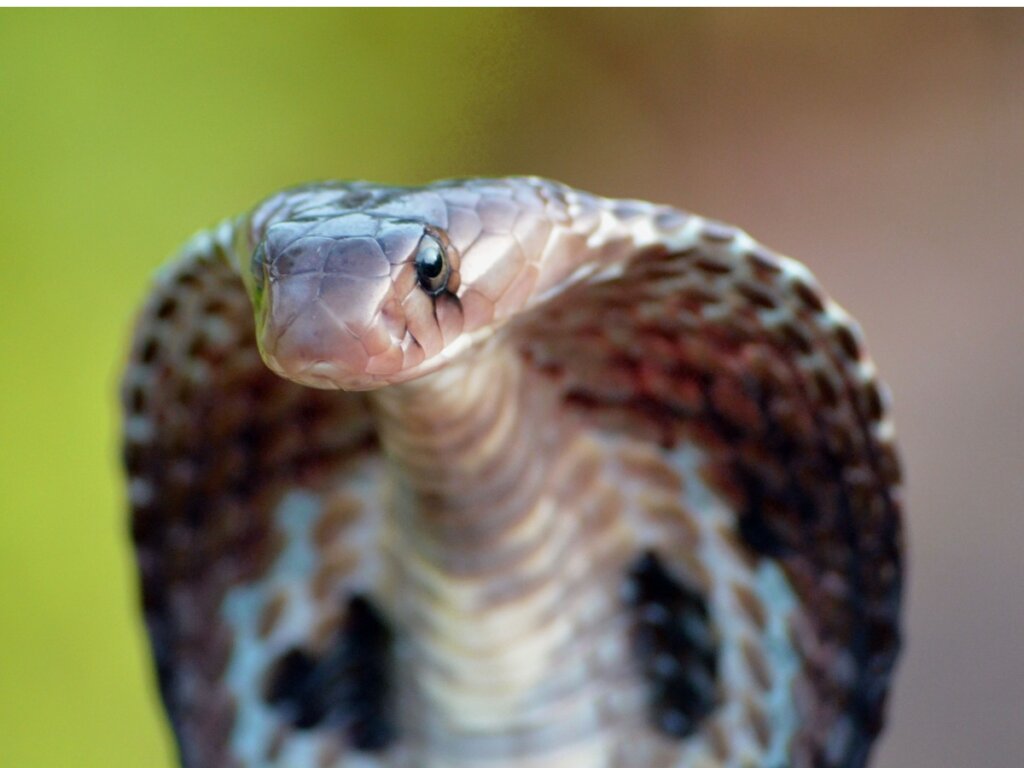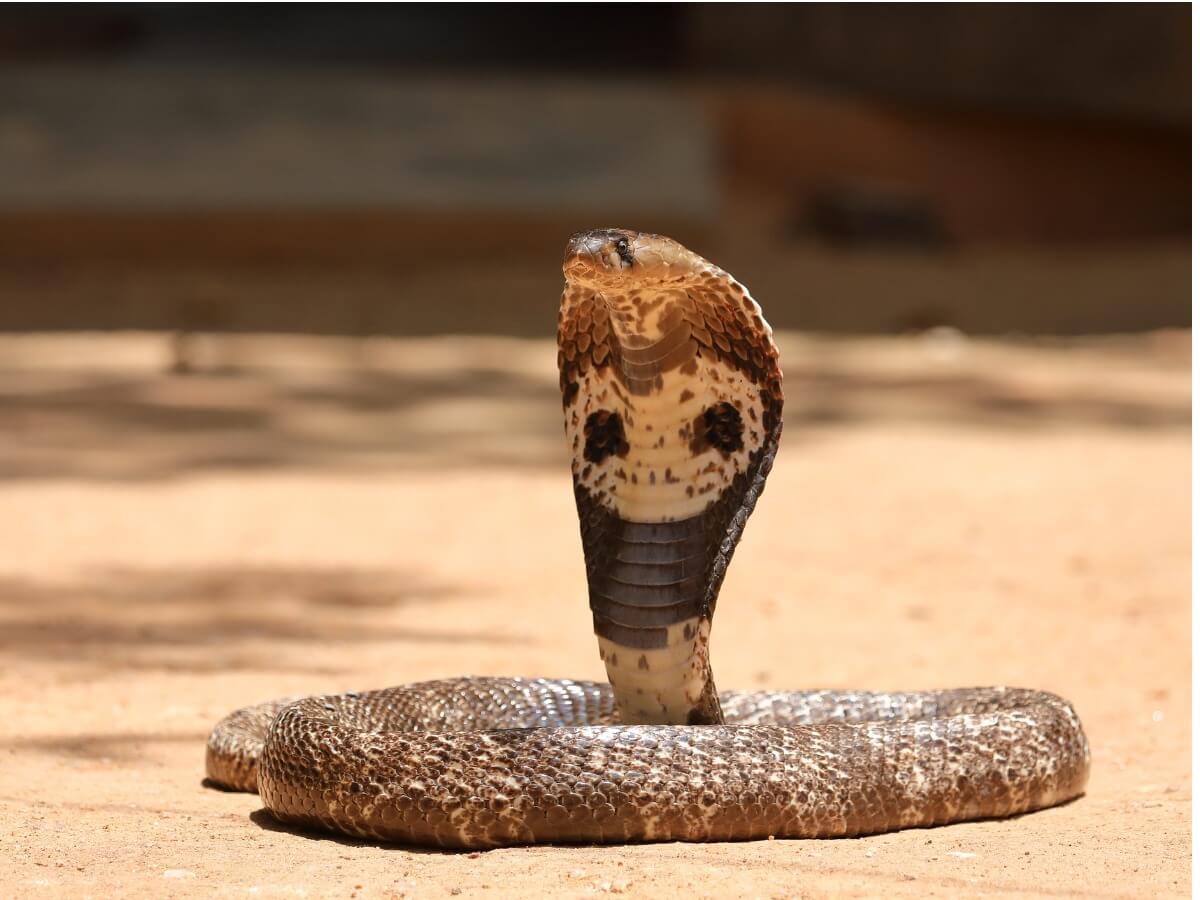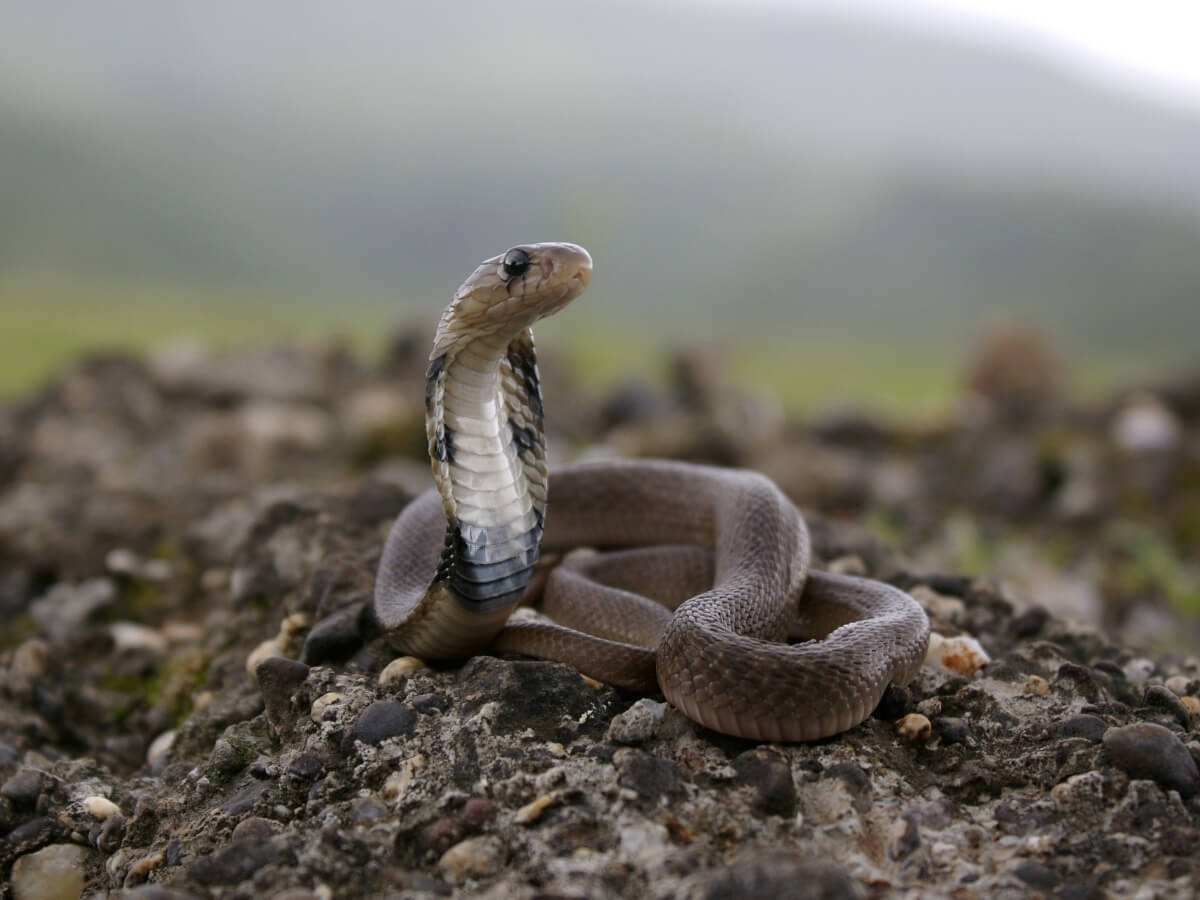Spectacled Cobra: Habitat and Characteristics

The spectacled cobra, also called the Indian cobra, is a peculiar reptile capable of spreading its skin wide, exhibiting a rather threatening posture. Although its appearance is common within the group of cobras, the venom it injects is considered one of the most lethal, which makes it feared by the local inhabitants.
There are many controversies with the taxonomy of cobras of the genus Naja, as their differences don’t seem to be so clear. However, in this space, we’ll focus on the Naja naja species, which is considered the basal specimen of most Indo-Asian cobras. Read on to learn more about this dangerous and beautiful reptile.
Habitat and distribution of the spectacled cobra
The spectacled cobra is a reptile from India whose distribution covers most of the subcontinent. For this reason, their presence has been recorded in Pakistan, Sri Lanka, Nepal, Bhutan, and Afghanistan. This species commonly inhabits different regions of forests, plains or open fields, although it can also be found in areas with human settlements.

What does the spectacled cobra look like?
The dimensions of this poisonous animal reach figures of more than 2 meters (6.6 feet) in length. In addition, its scales have a smooth finish, with colorations that vary between black, brown, and white. Moreover, in some cases, these same tones occur in band patterns, which are interspersed throughout their body.
Cobras have a very distinctive additional characteristic, as they have flexible ribs that are capable of stretching at will. This ability allows them to spread the skin of the upper part of the body to form a “hood” that extends in the form of “wings”. The result is what gives it its famous rising posture, which sets it apart from other snakes.
This spectacled cobra is characterized by having 2 black marks on its hood. One is on its back, and resembles glasses and another on its belly, which looks like two “eyes”. Of the two, the easiest to recognize is the one on its back, as the pattern of two circles joined by a curved line is the reason it has received its name.
Behavior
When this animal feels threatened, it extends its hood as a form of warning towards its enemy. Thanks to this, one-third of its body looks more voluminous, which serves to try to impact and deter its predator. What’s more, the two spots on its belly also serve to simulate giant eyes, which are an extra resource for aggressors to back off.
Poison
This species is one of the “four great snakes” of India, which are responsible for the highest number of human deaths in this country. The reputation it holds is no wonder, as its venom has paralyzing neurotoxins, whose effect on the heart is fatal. In other words, its toxins (cardiotoxins) can cause death due to cardiorespiratory arrest.
Fortunately, there are currently effective antivenoms against this animal’s lethal bite. In fact, thanks to medical advances (and with proper treatment) the probability of dying is quite low, even without having antivenom on hand.
What does the spectacled cobra eat?
The diet of this cobra is made up of rodents, lizards, and frogs, which are stalked until it finds the perfect moment to strike. For this reason, its venom is a great tool, helping it to paralyze and kill its victim almost immediately. Once the prey can no longer fight, it takes the opportunity to swallow it completely, just like any other snake.
This reptile is a skilled hunter, as it has the ability to locate its prey after having injected its venom into them. According to a study conducted by the University of Colorado , the cobra stalks its prey until it can inject its toxins and waits for them to take effect. In this way, even if the victim moves for a few more centimeters, the snake can follow its trail by means of its forked tongue.
Reproduction
Like most reptiles, this species of cobra is oviparous, so reproduction ends with the laying of its eggs. To achieve this, the male begins courtship by means of “coiling”. He intertwines with the female and they roll several times on the ground. This process ends with copulation, in which the male penetrates the female, stopping the entire ritual.
After two weeks, the new mother lays between 12 and 20 eggs in her nest. This site consists of a burrow, trunk, or hole that serves to protect them all. These small shells will hatch after 80 days of incubation. In fact, all the young are born very active, which is why at the slightest provocation they usually extend their hoods.
Although most snakes tend to abandon their young after oviposition, female cobras have some parental care. This is observed in their behavior, as they become more aggressive to protect their nest and even refuse to abandon it despite the danger.
Conservation status
The International Union for the Conservation of Nature doesn’t have this species classified in any category. On the contrary, the Convention on International Trade in Endangered Species of Wild Fauna and Flora groups it in its appendix 2. This means that, despite not being threatened, it could become so if the exploitation of its specimens isn’t controlled.
Individuals of this species are very abundant in their native areas, which is why it’s common for them to be used for traditional medicine. In addition, they’ve recently become very popular for their use in textiles and as pets, causing them to be hunted in several locations to satisfy the market.

It’s true that these snakes represent a danger to humans. However, this isn’t a reason to kill them. In fact, in most poisonous species there’s a hidden benefit, as their toxins can be used to create new drugs. The cobra can go from being the worst enemy to becoming a real hero, but it all depends on whether they manage to survive until then.
All cited sources were thoroughly reviewed by our team to ensure their quality, reliability, currency, and validity. The bibliography of this article was considered reliable and of academic or scientific accuracy.
- Akbari, A., Rabiei, H., Hedayat, A., Mohammadpour, N., ZOU, A. H., & TEYMOURZADEH, S. (2010). Production of effective antivenin to treat cobra snake (Naja naja oxiana) envenoming.
- Britt, A., & Burkhart, K. (1997). Naja naja cobra bite. The American journal of emergency medicine, 15(5), 529-531.
- Tryon, B. W. (1979). Reproduction in captive forest cobras, Naja melanoleuca (Serpentes: Elapidae). Journal of Herpetology, 13(4), 499-504.
- Lance, V., & Lofts, B. (1978). Studies on the annual reproductive cycle of the female cobra, Naja naja. IV. Ovarian histology. Journal of morphology, 157(2), 161-179.
- Mukherjee, A. K., & Maity, C. R. (2002). Biochemical composition, lethality and pathophysiology of venom from two cobras—Naja naja and N. kaouthia. Comparative Biochemistry and Physiology Part B: Biochemistry and Molecular Biology, 131(2), 125-132.
- Shashidharamurthy, R., Jagadeesha, D. K., Girish, K. S., & Kemparaju, K. (2002). Variation in biochemical and pharmacological properties of Indian cobra (Naja naja naja) venom due to geographical distribution. Molecular and cellular biochemistry, 229(1), 93-101.
- Mukherjee, A. K., & Maity, C. R. (1998). The composition of Naja naja venom samples from three districts of West Bengal, India. Comparative biochemistry and physiology part A: molecular & integrative physiology, 119(2), 621-627.
- Chiszar, D., Stimac, K., Poole, T., Miller, T., Radcliffe, C. W., & Smith, H. M. (1983). Strike induced chemosensory searching in cobras:(Naja naja kaouthia, N. mossambica pallida). Zeitschrift für Tierpsychologie, 63(1), 51-62.
- Deshmukh, R. V., Deshmukh, S. A., Badhekar, S. A., & Katgube, S. D. (2021). Unusual feeding behavior by a Spectacled Cobra, Naja naja (Linnaeus 1785) in India. Reptiles & Amphibians, 28(1), 32-33.
- Mavromichalis, J. M., & Bloem, S. A. (1995). A successful breeding of Naja naja sputatrix atra. Litteratura Serpentium, 15(2), 26-30.
- Suryamohan, K., Krishnankutty, S. P., Guillory, J., Jevit, M., Schröder, M. S., Wu, M., … & Seshagiri, S. (2020). The Indian cobra reference genome and transcriptome enables comprehensive identification of venom toxins. Nature genetics, 52(1), 106-117.
